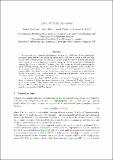Level set Cox processes
Abstract
An extension of the popular log-Gaussian Cox process (LGCP) model for spatial point patterns is proposed for data exhibiting fundamentally different behaviors in different subregions of the spatial domain. The aim of the analyst might be either to identify and classify these regions, to perform kriging, or to derive some properties of the parameters driving the random field in one or several of the subregions. The extension is based on replacing the latent Gaussian random field in the LGCP by a latent spatial mixture model specified using a categorically valued random field. This classification is defined through level set operations on a Gaussian random field and allows for standard stationary covariance structures, such as the Matérn family, to be used to model random fields with some degree of general smoothness but also occasional and structured sharp discontinuities. A computationally efficient MCMC method is proposed for Bayesian inference and we show consistency of finite dimensional approximations of the model. Finally, the model is fitted to point pattern data derived from a tropical rainforest on Barro Colorado island, Panama. We show that the proposed model is able to capture behavior for which inference based on the standard LGCP is biased.
Citation
Hildeman , A , Bolin , D , Wallin , J & Illian , J B 2018 , ' Level set Cox processes ' , Spatial Statistics , vol. 28 , pp. 169-193 . https://doi.org/10.1016/j.spasta.2018.03.004
Publication
Spatial Statistics
Status
Peer reviewed
ISSN
2211-6753Type
Journal article
Description
The authors gratefully acknowledge the financial support from the Knut and Alice Wallenberg Foundation, the Swedish Research Council Grant 2016-04187, and the ÅForsk foundation. Numerous organizations have provided funding, principally the U.S. National Science Foundation, and hundreds of field workers have contributed. The Barro Colorado soil survey was funded by NSFDEB021104, 021115, 0212284, 0212818 and OISE0314581 as well as the STRI Soils Initiative and CTFS.Collections
Items in the St Andrews Research Repository are protected by copyright, with all rights reserved, unless otherwise indicated.

